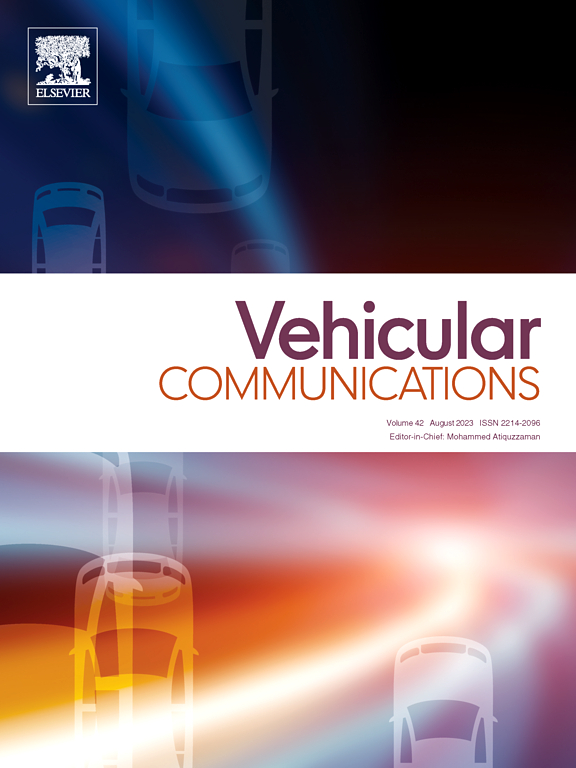Dynamic offloading strategy in SAGIN-based emergency VEC: A multi-UAV clustering and collaborative computing approach
IF 6.5
2区 计算机科学
Q1 TELECOMMUNICATIONS
引用次数: 0
Abstract
Mobile edge computing (MEC) technology can provide stable and efficient computing services for ground vehicles and users. However, maintaining stable MEC services becomes challenging in scenarios where ground MEC servers are damaged or unavailable, such as in post-disaster or remote areas. To tackle this issue, this paper proposes a novel space-air-ground integrated network (SAGIN) based emergency vehicular edge computing (VEC) framework, leveraging the rapid deployment characteristic of unmanned aerial vehicle (UAV) to provide VEC services for ground vehicles. A distance-based UAV clustering (DUC) algorithm is designed for efficient multi-UAV collaboration, executed by low earth orbit (LEO) satellite with wide coverage. Within each cluster, a task splitting algorithm based on a novel expected computing delay (ECD) metric is performed by the cluster-head UAV (CHU). Focusing on the issue of limited line-of-sight (LoS) range of UAV and computing sustainability during vehicle moving, we propose a dynamic offloading strategy. Simulation results show that the proposed framework enhances UAV utilization by 60% and significantly reduces task process delays across varying scenarios.
基于sagin的应急VEC动态卸载策略:一种多无人机聚类与协同计算方法
移动边缘计算(MEC)技术可以为地面车辆和用户提供稳定高效的计算服务。然而,在地面MEC服务器损坏或不可用的情况下,例如灾后或偏远地区,维持稳定的MEC服务变得具有挑战性。针对这一问题,本文提出了一种新的基于天空地一体化网络(SAGIN)的应急车辆边缘计算(VEC)框架,利用无人机(UAV)的快速部署特性,为地面车辆提供VEC服务。设计了一种基于距离的无人机聚类(DUC)算法,以实现覆盖范围广的近地轨道(LEO)卫星上的多无人机高效协同。在每个簇内,簇头无人机(CHU)基于一种新的期望计算延迟(ECD)度量执行任务分割算法。针对无人机有限视距和车辆移动可持续性计算问题,提出了一种动态卸载策略。仿真结果表明,该框架提高了60%的无人机利用率,显著降低了不同场景下的任务过程延迟。
本文章由计算机程序翻译,如有差异,请以英文原文为准。
求助全文
约1分钟内获得全文
求助全文
来源期刊

Vehicular Communications
Engineering-Electrical and Electronic Engineering
CiteScore
12.70
自引率
10.40%
发文量
88
审稿时长
62 days
期刊介绍:
Vehicular communications is a growing area of communications between vehicles and including roadside communication infrastructure. Advances in wireless communications are making possible sharing of information through real time communications between vehicles and infrastructure. This has led to applications to increase safety of vehicles and communication between passengers and the Internet. Standardization efforts on vehicular communication are also underway to make vehicular transportation safer, greener and easier.
The aim of the journal is to publish high quality peer–reviewed papers in the area of vehicular communications. The scope encompasses all types of communications involving vehicles, including vehicle–to–vehicle and vehicle–to–infrastructure. The scope includes (but not limited to) the following topics related to vehicular communications:
Vehicle to vehicle and vehicle to infrastructure communications
Channel modelling, modulating and coding
Congestion Control and scalability issues
Protocol design, testing and verification
Routing in vehicular networks
Security issues and countermeasures
Deployment and field testing
Reducing energy consumption and enhancing safety of vehicles
Wireless in–car networks
Data collection and dissemination methods
Mobility and handover issues
Safety and driver assistance applications
UAV
Underwater communications
Autonomous cooperative driving
Social networks
Internet of vehicles
Standardization of protocols.
 求助内容:
求助内容: 应助结果提醒方式:
应助结果提醒方式:


